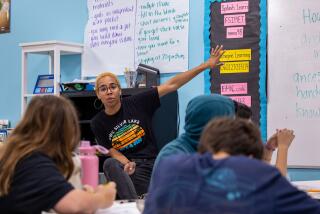History Teachers Make Their Students Live the Subject
The things Mrs. Sambar’s eighth-graders say behind her back would make a lesser teacher consider a new career--say, chief window washer for a 60-story skyscraper.
Many of her 13- and 14-year-old students complain that she makes them work too hard and call her assignments crazy. Others ‘fess up to every once in a while actually “hating” this mild-mannered, silver-haired mother of three grown men who teaches advanced history at Rosemont Middle School.
“I’m afraid of what she’s going to think of next,” Helena Park, one of Mary Sambar’s students at the La Crescenta school, says with a laugh.
What keeps Sambar, a teacher for 20 years, from hanging precariously from a strap outside a massive glass building, however, is the other things they say about her.
“She hates regurgitation (of facts) and she makes us think,” Josh Weyand said.
“She gets involved, gets us thinking,” Tiffney Mortensen said.
The object of those accolades presides over a standard-issue history classroom. Pictures of presidents and a shot of the nation’s capital at moonlight adorn the walls. A “Gone With the Wind” movie poster and Confederate and American flags remind students they are studying the Civil War.
But the way these eighth-graders study that war is anything but standard-issue. They are taking part in a very technical-sounding “interdisciplinary, collaborative project.”
Translated?
They will study the history of that epic period with Sambar and read literature relating to it in Sara Jackson’s advanced English class. They will then break into smaller groups and work on a project--in this case, a skit--that will reflect their understanding of the topic.
This interdisciplinary approach to teaching is not unique to Rosemont.
Principal Lois Neil, noting that the latest educational buzzwords are “critical thinking” and “cooperative learning,” said the state in 1986 urged schools to “build a connectiveness between courses.”
Sambar said, “Any groups of kids can do this, if the teacher takes the time and wants them to do it.”
Yet, at the beginning of the year, when the students took on their first Sambar-Jackson project--a Colonial-era quilt that would reflect the roots of intolerance in American history--the students were skeptical.
“When we told them about it, they said, ‘This is too big a project,’ ” Sambar said. “They were so negative that we (the teachers) were all very pessimistic about how it would turn out.”
Despite those low expectations, Sambar and Jackson went ahead with their plan. In history lessons, Sambar discussed the Pilgrims, American Indians, slavery, even the Holocaust.
Jackson, a teacher for six years, assigned the 72 students (two classes of 36) books that tackled the problems of religious, racial and cultural intolerance. The youngsters were then divided into groups of threes and fours and given the task of creating a panel for the quilt that would express the lessons they learned from their history and English studies.
They were given four hours and were not allowed to buy any materials. Even though they weren’t working for a grade, they argued, argued, argued. Yet they also managed to cooperate enough to get the job done.
“The individual pieces didn’t look that good until we put it all together,” Sambar said. “They were astonished that it looked that great.”
And these students who, as Josh Weyand said, are “fortunate, because we’re pampered and we don’t have to deal with a lot of the problems (of intolerance),” learned the kind of lessons they are not likely to forget.
Michelle Lee said that, as a native of South Korea, she was appalled to learn about the American internment camps for the Japanese during World War II.
“It didn’t surprise me, but I was kind of angry,” said Lee, whose family came to the United States in 1982. “It probably would have happened to my family if we were here.”
Or Adriana Dmitrevsky, who translated her lessons from her classroom into the small, but important, lessons of life.
“You can’t be wishy-washy in life,” she said. “If you can’t make a decision, other people will make it for you.”
Most of all, the youngsters have learned the importance of being challenged. Which is why Sambar endures her students’ complaints.
“I am tough, and they know it,” she said. “I am not here to be their friend, and I’m sure every single one of them says, ‘I hate Mrs. Sambar’ at one time or another.
“They hate me. But they won’t say they hate history.”
More to Read
Sign up for Essential California
The most important California stories and recommendations in your inbox every morning.
You may occasionally receive promotional content from the Los Angeles Times.









